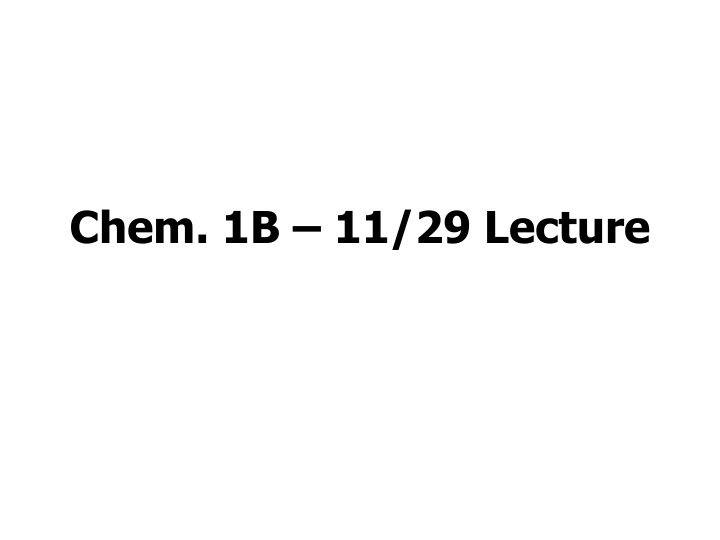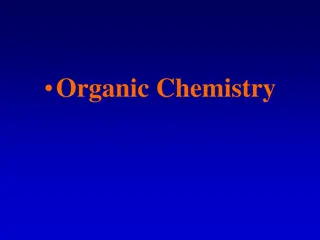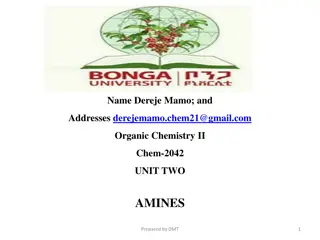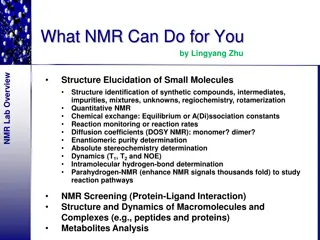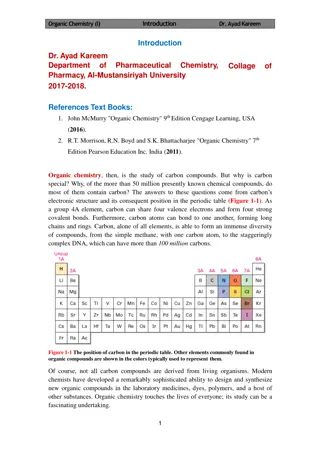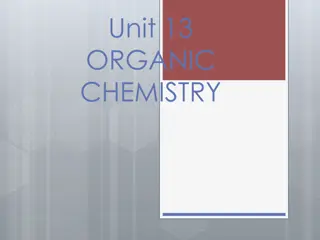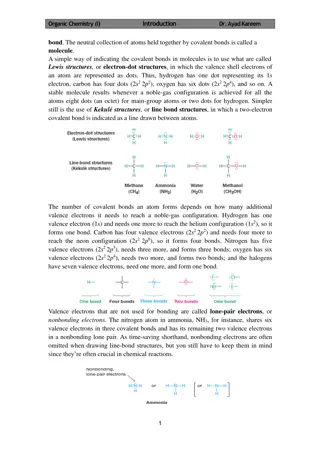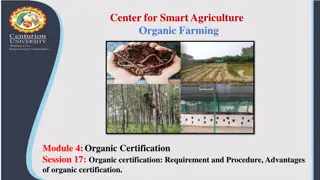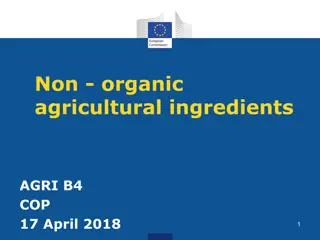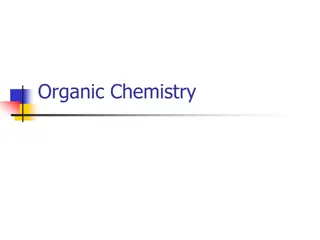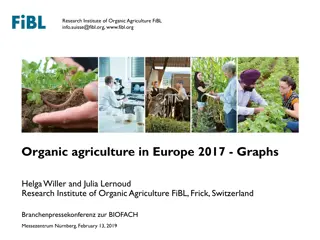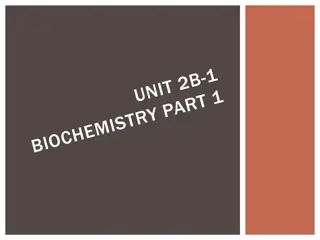Organic Chemistry Fundamentals
Organic Chemistry is a vital field of study focusing on the nature of carbon-carbon bonds, hydrocarbons, reactions, and functional groups. Carbon forms stable bonds with itself, mainly utilizing sp to sp3 hybridization. Understanding these basics is essential for grasping the intricate world of organic compounds and their properties in various chemical reactions and applications.
Download Presentation

Please find below an Image/Link to download the presentation.
The content on the website is provided AS IS for your information and personal use only. It may not be sold, licensed, or shared on other websites without obtaining consent from the author.If you encounter any issues during the download, it is possible that the publisher has removed the file from their server.
You are allowed to download the files provided on this website for personal or commercial use, subject to the condition that they are used lawfully. All files are the property of their respective owners.
The content on the website is provided AS IS for your information and personal use only. It may not be sold, licensed, or shared on other websites without obtaining consent from the author.
E N D
Presentation Transcript
Announcements I Lab Last Lab #15 (yesterday and today) Lab #15 Report due next Mon. + Tues Lab Final next week (Wed. + Thurs.) see syllabus for labs covered need scantron Mastering Ch. 20 assignment (Organic Chemistry) due 12/10
Announcements II Exam 3 Thursday On Electrochemistry (~55%) and Chapter 24 (~45%) Help Session Tues. afternoon (with PALs I can do 4:00 to 4:45) Today s Lecture Organic Chemistry (Ch. 20)
Chapter 20 Organic Chemistry Introduction Organic Chemistry is a major area of study (we offer 7 organic chemistry classes at the undergraduate level) In ~1.5 weeks, we only have time to introduce basic principles of organic chemistry
Chapter 20 Organic Chemistry Overview Nature of Carbon Carbon Bonds Hydrocarbons (structure, naming and isomers) Reactions Aromatic Hydrocarbons Functional Groups
Chapter 20 Organic Chemistry Nature of Carbon Carbon Bonds Carbon is one of the few elements that form fairly stable bonds with itself Most alkanes (hydrocarbons with only single bonds), while combustible in air (more stable as CO2+ H2O), have negative Gf Carbon likes to form 4 bonds ([He]2s22p2, but mostly forms sp to sp3hybrid bonds)
Chapter 20 Organic Chemistry Nature of Carbon Carbon Bonds Simplest hydrocarbon is CH4, methane, in which sp3hybridization occurs (tetrahedral geometry) As carbon carbon bonds are common, in alkanes, they also occur with sp3 hybridization (tetrahedral for each C atom)
Chapter 20 Organic Chemistry Nature of Carbon Carbon Bonds Example alkane with a carbon carbon bond is ethane: CH3CH3 All bonds are sigma bonds in alkanes This means constituents may rotate about bond H H H C C H H H H C C H H H H H
Chapter 20 Organic Chemistry Nature of Carbon Carbon Bonds Hydrocarbons containing double bonds are known as alkenes Hybridization is sp2 (see ethene structure below drawn in 3D) so all atoms in one plane remaining p orbital forms bond H H C C Because of bond, rotation about C-C axis doesn t occur at room temperature H H
Chapter 20 Organic Chemistry Hydrocarbon Structures Linear alkanes: CH3(CH2)nCH3 Carbon skeleton structure Example butane = No. Carbons 1 name Methane 2 Ethane 3 Propane 4 n-Butane 5 n-Pentane Only bonds shown as lines and carbons as kinks (Hs omitted)
Chapter 20 Organic Chemistry Hydrocarbon Structures Branched structures: Example isobutane = CH3CHCH3 CH3 Butane and isobutane are structural isomers (have the same number of Cs and Hs, but are structurally different) Branched compounds have greater volatility than their linear isomers
Chapter 20 Organic Chemistry Hydrocarbon Structures Optical Isomers As was mentioned in Chapter 24, tetrahedral structures with 4 different constituents (CWXYZ with C in center) will have optical isomers Hydrocarbon example (3-methyl hexane) Chiral carbon (carbon with 4 different constituents) shown with star (constituents are -H, -CH3, -C2H5, and -C3H7
Chapter 20 Organic Chemistry Hydrocarbon Structures Branched structures: Example isobutane = CH3CHCH3 CH3 Butane and isobutane are structural isomers (have the same number of Cs and Hs, but are structurally different) Branched compounds have greater volatility than their linear isomers
Chapter 20 Organic Chemistry Hydrocarbon Structures Optical Isomers cont. Two different (3D) structures can be drawn of 3- methyl hexane corresponding to mirror images Each enantiomer (version) will have identical properties except for ability to rotate light and ability to interact with other chiral compounds Reactions in living organisms typically produce only one of two mirror images (also known as enantiomers), while synthetic reactions often produce both isomers (known as racemic mixtures)
Chapter 20 Organic Chemistry Some Questions 1. Which of the following skeleton structures corresponds to n-hexane? 2. Which pentane isomer will have the lowest boiling point?
Chapter 20 Organic Chemistry Alkanes Sources: Structures: Linear Branched Cyclic Plant/animal products (mostly historic) Petroleum (main source) Synthesis from coal, natural gas, or biomass Cyclopentane in C skeleton structure Note: cyclopentane (C5H10) is NOT an isomer of n-pentane or isopentane (C5H12) as it has 2 fewer Hs
Chapter 20 Organic Chemistry Example of Contract for Alkane Research with Sacramento Based Alternative Fuel Company Company (Greyrock Energy) is working to produce diesel fuel from agricultural waste or stranded gas (natural gas normally vented in oil operations) They produce diesel in the following process: CnH2nOn + heat CO(g) + H2(g) and CO(g) + H2(g) + catalyst H2n+2Cn (various) + H2O(l)
Chapter 20 Organic Chemistry Contract Research Example My job (or that of students working for me) was to determine H2n+2Cn (various) + other impurities (benzene, alkenes, alcohols) Four phases produced (liquid water, gas alkanes methane to butane used to generate power, hydrocarbon liquid or crude synthetic diesel, and wax or solid hydrocarbons) Q. Does structure of hydrocarbons matter? A. Yes. Linear alkanes generally best for diesel, while branched alkanes are good for gasoline but poor for diesel (increases octane rating)
Chapter 20 Organic Chemistry How did we determine the composition of the diesel fuel? Gas chromatography (similar to paper chromatography lab not done) Major constituents were-alkanes (biggest peaks) This sample had relatively high branched alkanes (most of yellow peaks) Other significant constituents are alkenes (green peaks) FID1 B, (YVONNE\08081301.D) 14.714 1.756 1.824 pA C16 FID1 B, (YVONNE\08081301.D) 180 pA 10.742 160 60 140 50 8.269 120 6.764 5.013 40 100 3.244 9.573 30 10.742 80 10.800 11.813 10.284 10.237 10.412 12.809 2.143 10.908 20 60 10.332 13.490 13.764 10.653 10.585 6.865 8.349 2.974 3.120 15.655 16.604 5.142 9.638 6.008 6.162 17.556 40 10.800 6.292 6.423 10 18.502 7.723 4.519 4.594 19.438 20.354 22.964 22.120 10.284 21.249 23.834 9.078 7.859 8.468 2.884 6.994 7.164 10.237 10.412 3.369 11.864 24.784 9.209 11.386 10.908 11.509 25.850 5.289 11.334 12.324 2.737 9.039 9.751 12.404 1.707 10.332 14.206 12.856 12.527 12.356 13.277 4.378 4.407 11.975 13.369 14.439 11.435 13.315 7.760 14.259 15.137 2.768 10.653 12.965 2.194 9.125 12.454 14.314 13.810 16.070 17.009 11.733 13.417 3.504 1.961 15.201 15.258 8.151 15.386 11.263 14.364 6.626 16.206 16.146 16.336 15.308 17.158 17.291 10.585 9.472 11.669 3.317 4.858 1.634 2.040 8.969 2.267 7.940 7.632 3.184 9.262 8.069 6.706 6.537 2.809 2.087 4.784 9.859 9.908 8.662 5.658 4.643 10.2 10.4 10.6 10.8 11 min 20 0 5 10 15 20 25 min Chromatogram (each peak = 1 compound)
Chapter 20 Organic Chemistry Alkanes Naming compounds Linear Alkanes (see table in text should know methane to decane) Branched alkanes Example Start with longest possible chain Assign numbers to each carbon Add branching constituents name based on number of carbons added (methane becomes methyl for CH3) order is alphabetical
Chapter 20 Organic Chemistry Questions 1. What is the name of CH3CH2CH3? Does it have a branched isomer? 2. What is the name of CH3CHCH3? CH2CH3 3. Determine the name and formula of the compound given its carbon skeleton structure below: A B 4. Does the compound in 3) have optical isomers? 5. Give the number of Hs attached to Cs at A and B
Chapter 20 Organic Chemistry Alkenes Contain at least 1 carbon-carbon double bond Naming (replace ane ending with ene with number referring to end of double bond closest to the #1 carbon) Example: CH3CH=CHCH3 is 2-butene Other isomer (CH3CH2CH=CH2) is 1-butene
Chapter 20 Organic Chemistry Alkenes Effects of double bonds: structural effect increases melting point temperatures makes compounds more reactive/less stable Examples in fats, oils and biodiesel Fats and oils are triglycerides containing three fatty acids (alkane or alkene in nature) O CH3 O H3 C O O CH3 O O
Chapter 20 Organic Chemistry Alkenes Fatty Acid Examples Fatty acids are linear hydrocarbons with a carboxylic acid terminus Size is typically 12 to 22 carbons in length (18 most common) with 0 to 3 double bonds Animal fats mostly have 0 double bonds and are solids at room temperature Used in biodiesel, these compounds have high cloud point temperatures (gel in fuel tanks at low temperatures)
Chapter 20 Organic Chemistry Alkenes Fatty Acid Examples Most plant fats have fatty acids with double bonds (cis- isomer) and are liquids at room temperature Biodiesel made from plant fats has minimal cloud point problems (but does have some oxidation problems) Why? Kink from double bonds reduces van der Waals attractions between neighboring hydrocarbon chains, decreasing melting point temperatures CH3 H O O CH3 H O O H O O H3 C
Chapter 20 Organic Chemistry Alkenes Cis Trans Isomers Because double bond is a barrier to rotation, cis- and trans- isomers occur for alkenes Example 2-butene can be either cis- or trans- H CH3 H H C C C C CH3 H CH3 CH3 cis-2-butene trans-2-butene
Chapter 20 Organic Chemistry Alkenes Cis Trans Isomers Are there differences between cis- and trans- isomers? Large differences in melting points for example between natural plant fatty acids (almost always cis-) and trans- fatty acids formed as a bi-product of hydrogenation (partial conversion from alkenes to alkanes) Trans- forms have very small kink vs. cis- fatty acids (and are also known to be unhealthy) cis- trans-
Chapter 20 Organic Chemistry Alkenes In Synthetic Diesel 1- and 2-dodecene (C12) shown 1-alkene FID1 B, (YVONNE\08081301.D) pA 10.742 2-alkenes 60 50 40 30 10.800 10.284 10.237 10.412 10.908 20 10.332 10.653 10.585 10 10.2 10.4 10.6 10.8 11 min Why 2 peaks for 2-alkenes and 1 for 1- alkene?
